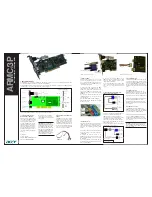
by the hPC Challenge Benchmark suite, is nearly identical to its ping-pong
latency, even as you increase the number of nodes.
the InfiniPath adapter, using a standard Linux distribution, also achieves the
lowest tCP/IP latency and outstanding bandwidth.
3
eliminating the excess
latency found in traditional interconnects reduces communications wait time
and allows processors to spend more time computing, which results in ap-
plications that run faster and scale higher.
Lowest CPU Utilization.
the InfiniPath connectionless environment elimi-
nates overhead that wastes valuable CPU cycles. It provides reliable data
transmission without the vast resources required by connection-oriented
adapters, thus increasing the efficiency of your clustered systems.
Built on Industry Standards.
the InfiniPath adapter supports a rich com-
bination of open standards to achieve industry-leading performance. the
InfiniPath OpenIB software stack has been proven to be the highest perfor-
mance implementation of the OpenIB Verbs layer, which yields both superior
latency and bandwidth compared to other InfiniBand alternatives.
•
InfiniBand 1.1 4X Compliant
•
standard InfiniBand fabric management
•
MPI 1.2 with MPICh 1.2.6
•
OpenIB supporting IPoIB, sDP, UDP and sRP
•
PCI express x8 expansion slot Compatible
•
supports sUse, Red hat, and Fedora Core Linux
D a t a s h e e t
© 2006 QLogic Corporation. all rights reserved. QLogic, the QLogic Logo, Pathscale, InfiniPath, and accelerating Cluster Performance are registered trademarks or trademarks of QLogic. hypertransport and htX are licensed trademarks of the hypertransport technology
association. aMD, the aMD arrow logo, aMD Opteron and combinations thereof are trademarks of advanced Micro Devices, Inc. Other trademarks are the property of their respective owners.
sN0058045-00 Rev D 11/06
Corporate headquarters
QLogic Corporation 26650 aliso Viejo Parkway aliso Viejo, Ca 92656 949.389.6000
europe headquarters
QLogic (UK) LtD. surrey technology Centre 40 Occam Road Guildford surrey GU2 7YG UK +440(0)1483 295825
InfiniPath QHT7140
HyperTransport Interface
•
ht v1.0.3 compliant
•
htX slot compliant
•
6.4 GB/s bandwidth
•
asIC supports a tunnel configuration with
upstream and downstream ports at 16 bits
@1.6 Gt/s
Connectivity
•
single InfiniBand 4X port (10+10 Gbps) –
Copper
•
external fiber optic media adapter module
support
•
Compatible with managed InfiniBand switches
from Cisco®, silverstorm™, Mellanox®, and
Voltaire®
•
Interoperable with host channel adapters (hCas)
from Cisco, silverstorm, Mellanox and Voltaire run-
ning the Open Fabrics software stack
QLogic Host Driver/Upper level
Protocol (ULP) Support
•
MPICh version 1.2.6
•
tCP, NFs, UDP, sOCKets through ethernet driver
emulation
•
Optimized MPI protocol stack supplied
•
32- and 64-bit application ready
•
sDP, sRP, IPoIB supported through OpenFabrics
stack
InfiniBand Interfaces and specifications
•
4X speed (10+10 Gbps)
•
Uses standard IBta 1.1 compliant fabric and
cables; Link layer compatible
•
Configurable MtU size (4096 maximum)
•
Integrated seRDes
Management Support
•
Includes InfiniBand 1.1 compliant sMa (subnet
Management agent)
•
Interoperable with management solutions from
Cisco, silverstorm,, and Voltaire
Regulatory Compliance
•
FCC Part 15, subpart B, Class a
•
ICes-003, Class a
•
eN 55022, Class a
•
VCCI V-3/2004.4, Class a
Operating Environments
•
supports 64-bit Linux with 2.6.11 kernels
- Red hat enterprise Linux 4.x
- sUse Linux 9.3 & 10.0
- Fedora Core 3 & Fedora 4
•
Uses standard Linux tCP/IP stack
QLogic InfiniPath Adapter Specifications
•
typical Power Consumption: 5 Watts
•
available in PCI half height short and PCI full
height short form factors
•
Operating temperature: 10 to 45°C at 0-3km –
30 to 60°C (Non-operating)
•
humidity 20% to 80% (Non-condensing,
Operating) 5% to 90% (Non-operating)
QLogic InfiniPath ASIC Specifications
•
hFCBGa package, 841 pin, 37.5 mm x 37.5 mm
ball pitch
•
330 signal I/Os
•
4.1W typical (ht cave), 4.4W typical (ht tunnel)
•
Requires 1.2V and 2.5V supplies, plus interface
reference voltages
1
Ping-pong latency and uni-directional bandwidth were measured by Dr. D. K. Panda on 2.8 Ghz processors at Ohio state University using the standard OsU Ping-pong latency test.
2
the n1⁄2 measurement was done with a single processor node communicating to a single processor node through a single level of switch. When measured with 4 processor cores per node
the n1⁄2 number was further improved to 88 bytes and 90% of the peak bandwidth was achieved with data packets of approximately 640 bytes.
3
tCP/IP bandwidth and latency were measured using Netperf and a standard Linux tCP/IP software stack.
Note: actual performance measurements may be improved over data published in this document. all current performance data is available in the InfiniPath section of the QLogic website at
www.qlogic.com/pathscale.




















